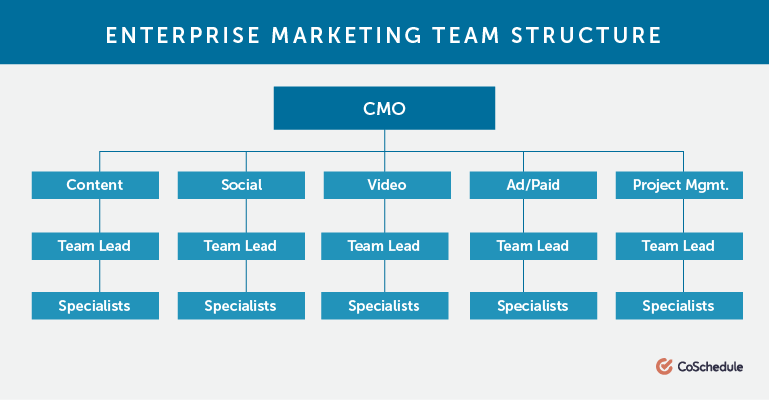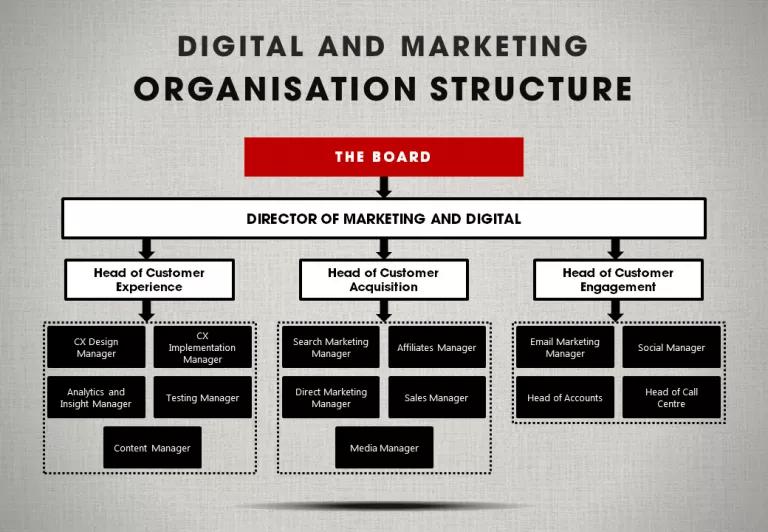
A Digital Marketing Job Titles List for Growing Company Structures
In the first two blog posts of this series, we covered optimal marketing department structures and what you should look for in specific roles.
This final blog post showcases a digital marketing job titles list to help you understand which roles to add to your growing company. You’ll also discover how you can get affordable, quality talent; find out what top industry experts recommend; and learn how to fix common problems that arise with marketing organization structures.
Big businesses: high-level leaders
As your team size grows, you’ll need to add high-level managers and leaders. Marketing team structures, especially for agencies, inevitably get split into an “account manager” group that communicates progress to clients and a “producer” group that does the work. Numerous new management jobs pop up to help lead the ever-growing groups.
Great leaders understand the vision of their company. Moreover, they remove any obstacles that prevent employees from doing the best work they can. Their guidance will help a company move towards accomplishing its big, hairy, audacious goals (BHAGs).
Here are some of the common roles you’ll see in the market that you can consider adding to your company:
Account Executive (AE)
Account executives lead account managers to help them communicate progress and goals between the producers and the clients. They clear any roadblocks that prevent their team from delivering the most important information between parties. Like engineers, they constantly seek to tweak their system and process for the best results. As an organization grows even larger, a director of account management may be necessary for managing AEs.
Copywriters and Art Directors (Creative Staff)
We mentioned in our last article that a creative director is a good hire. Under a creative director, other assistant producers help marketing deliverables achieve business calls through an artistic lens. An art director may be responsible for ensuring that a creative aligns with the brand. A copywriter may be responsible for testing persuasive language in ad copy to generate the highest response.
CMO or Vice President of Marketing
These professionals help the marketing department move towards their BHAG. They oversee managing, hiring, and developing people. At this point, hiring is one of the most important for your team—it can either make or break your marketing performance.
Your CMO or vice president of marketing acts as a conductor who looks at all the data and creates a map of how a visitor decides to become a customer. They also understand the customer journey at a high level. They know all the touchpoints prospects go through online, where they hang out, and how they interact with a web page before they purchase. This understanding helps a CMO map out what strategy points need to change to achieve the big results.

Credit: CoSchedule
Director of Strategy
A director of strategy organizes and plans the overall strategy for all marketing accounts or the company. They direct and manage various producers to accomplish the marketing business goals set forth, which often involve multiple areas of digital marketing, such as Google ads, design, and SEO. Additionally, the director of strategy makes projections based on trends, threats, research, opportunities, and resources available to identify the best plan to achieve business results.
(More) Specialists
At the enterprise level, you can now consider adding more specialists to your team. Specialists are masters of a specific branch of digital marketing, such as search engine optimization or Facebook ads. It’s worth making this investment—a large organization thrives off specialized, diverse talent. You can add more specialists to your existing roles (social media, content managers, etc.) or create entirely new roles (lead management, PR, graphic artist, customer engagement, etc.).
Here are some major new roles you should consider:
- Email Marketing Manager
- Lead Management
- Blogger
- Marketing Technologist
- Events Coordinator
- Content Strategist
- Organic Social Media Manager
- Facebook Ads Specialist
Companies make the mistake of forcing a silo or specialization onto a group or individual. While there are benefits to specialization, your employee retention and abilities will increase if you let people learn about other areas of marketing if they want to.
Project Managers
As your organization grows, you should see fewer jack-of-all-trades managers who oversee all kinds of roles. Why? Because of comparative advantage—it’s not efficient to have everyone doing everything. Instead of overseeing everyone, project managers focus on new projects—specifically, they handle delegation, organization, team involvement, budgeting, and sometimes strategy.
Product Marketing Manager (aka Customer Marketing Lead)
A great product manager uses their excellent communication skills to educate prospects and turn them into customers. This professional is also adept at blogging and creating content upgrades. They can help lead the producers in their marketing.
Director/VP of Branding
Unless you want to compete purely based on your price and features, you’ll eventually want someone to keep tabs on and guide your brand. This director will define what your brand is, make sure all public-facing materials are on brand, and oversee initiatives that will grow the awareness and goodwill of customers so your business can command premium prices.
Sales Director (by region)
As your sales department grows, a director leads and organizes salespeople by the regions or industries they’re assigned to go after (e.g., you may see the role of “Sales Lead for Washington, D.C.”).
Keep the hierarchy as flat as possible
There will be a natural tendency and urge for companies to add multiple layers of hierarchy to manage the growth of team members. Inevitably, there will be managers of managers. Manage groups in tribes of around 150 people because that’s how many people humans are biologically wired to handle keeping track of.
Just make sure to keep the marketing job titles hierarchy as flat as possible; doing so will help a lot with information sharing from the bottom up and the top down. The worst thing you can do for your marketing company structure is to add numerous levels from your CEO down to the lowest worker. Because then, like in a game of telephone, a simple message gets distorted exponentially the more layers it must go through before reaching the final recipient.
Expert advice on team structure
According to Christine Cutten, Customer Principal and Customer Transformation Leader at Deloitte Consulting LLP, a great marketing department structure has:
- A great customer experience—one that can identify customer segments and create a customer-first experience.
- A marketing strategy—a specific annual marketing plan and budget.
- Marketing operations—optimization of execution across various departments.
Daryl Fielding, Director of Brand Marketing at Vodafone, says that the ideal marketing structure varies depending on your goals. You should have some mechanism in place to deal with any drawbacks of the team structure you opt for.
You must define roles by functionality, but also acknowledge fluidity. Each employee should have a depth of skill in one area and a moderate understanding of related skills (social media, SEO, PPC, email marketing, etc.) to become a T-shaped marketer.
Different functional teams should be defined because they can have different solutions to the same problem and give different perspectives. For example, if you ask a group of people to get you leads, some will point to PPC while others will point to SEO or social media.
Here’s a marketing org chart to illustrate this:

Credit: B2B Marketing Experiences
Make sure there is a leader for each team to remove obstacles and handle inter-departmental decisions and strategy. Departments should share different perspectives before executing crucial tasks.
Rob Heiser, CEO of Segmint, said that a marketing department should be structured to integrate with all lines of business. At Segmint, their teams are organized to focus on specific, overall business goals, such as market penetration, instead of having isolated silos around a particular product line or technology goal.
Jon Hexter, Marketing Director at Wincanton, has decided to use a team of jack-of-all-trades marketers with a few key specialists. By using supporting agencies to help in areas where he lacks (such as SEO and PPC), he has created flexibility while maintaining consistency.
Leah Anathan, CMO of PrestaShop, says that her key to success is organizing the marketing team structure to support top business priorities while retaining agility. She has multiple teams focus on traditional marketing (communications, product marketing, etc.), as well as a rapid-response team that works across all functions (digital and traditional).
Jen Gray, VP of Marketing and Creative Services at Hello World, emphasizes the importance of integration and speed of efficiency. She believes brick and mortar stores should fully integrate with online e-commerce websites. Jen has a great story to prove her point:
She was in a rush and received an email from a store for 30% off. She wanted to buy a gift for her son for the holidays and used the coupon. But when it arrived, it was the wrong item, even though the receipt showed the correct order! The holidays had almost come, so she rushed to the local mall to fix the issue. The store made her pay full price because the online store and brick-and-mortar store systems were “different entities.”
Jen says this issue shouldn’t happen in the digital age because the hassle delivers a poor customer experience. Rather, full integration of online and offline systems should be a norm. Finding ways of increasing speed and efficiency will help create the optimal experience for your audience. Don’t let the corporate structure of your team get in the way of communication. Jen will probably avoid the store from now on and may warn her friends—don’t be that business.
How to find affordable talent that hustles
Who doesn’t want affordable, top-tier talent that requires fewer hiring costs than traditional methods? Fortunately, it’s easier than you think—the secret to obtaining them is interns.
Because digital marketing is not a skill taught in schools, attracting interns accomplishes many goals:
- Some interns will go above and beyond to provide quality results because they have the ambition to get their foot in the door.
- You’ll be able to train them while they work, so you don’t have to waste time training a fresh employee that you hire.
- You can assess them on the job to see if they would make potentially great employees, thereby eliminating recruiting, hiring, and interview costs.
- If they don’t stay with you after the internship, they can go on to successfully apply the skills they learned elsewhere, which adds a lot of goodwill into the marketplace.
No matter the size of your business, you should build out an internship program. Summer internships are a great opportunity because you have a more focused period to get their help, teach them, and assess them. That said, winter internships are another option; there’s less competition in this period, which gives hungry talent a chance to get their hands dirty.
One strategy to test out interns is to assign them one major project and a few small projects. These could include: writing blog posts, helping with a webinar, writing eBooks, running small PPC accounts, or studying the data. You can figure out where they fit into your company by seeing which areas of marketing they shine and struggle while teaching them with real-world tasks.
How to find and attract interns
Believe it or not, people are dying to get their foot in the door to work for you—they just have a hard time finding you.
Here are some of the best things you can do to attract them:
- Show up at colleges. They’re one of the best places to find interns, bar none. Some of the best ways of getting noticed on campus include having a station at a job fair, passing out fliers in the right department, or speaking in front of specific digital classes.
- Make sure you have an intern application page on your website that’s easy to apply to. It should be free of glitches and intuitive.
- Find digital marketing, social media marketing, and business-themed college groups on Facebook and LinkedIn to share your openings with. Some of these groups are large. Facebook’s groups are usually more active than LinkedIn’s.
- Use job boards to advertise internship openings. Young students and professionals usually go to job boards first to find opportunities. Currently, the hottest job boards are LinkedIn, Indeed.com, and Craigslist.
- Ask your existing network and/or team for recommendations. They may know of someone in their network. Plus, many employees find their jobs through referrals from their connections.
- Search on LinkedIn using the advanced search. Filter by location, skills, keywords, and/or job title. The most ambitious candidates have a completed profile. Look for people in your area with keywords such as “digital marketing” or specific Google or HubSpot certifications in their title or profile.
Don’t just stick to in-house talent—there’s beauty in outsourcing
Outsourcing usually gets a bad rep, but the pros can far outweigh the cons. The practice has come a long way from merely contracting out work to someone anonymous in a third-world country and getting subpar results. The reality? You can get great work at a fraction of the cost these days. Thanks to outsourcing websites that show each person’s track record and reviews, you can find quality talent that you can actually trust.
Think of it less as replacing employees and more as extending the value you can provide to customers by contracting out work that no one in house excels at or enjoys. If you hire a person or agency for their specialized skills, you can get efficient help when you want.
The drawback of outsourcing is that you might not be able to talk to them in person and effectively communicate things thoroughly. Also, a remote worker could fail to adopt the company’s culture because of the physical distance, and that distant could potentially affect their work. That said, plenty of successful companies thrive with many remote employees, so it’s definitely worth a shot.
How to eliminate silos, inefficiencies, and work duplication
Not laying down crystal-clear expectations can lead to teams duplicating tasks or lacking clarity as to who’s responsible for overseeing and passing on duties.
Establishing clear responsibilities and efficient communication within departments is imperative. Collaboration is crucial to eliminating task duplication and silos so that different departments can make decisions with thoughtful input from other departments. In turn, working together will eliminate needless wastes of time or unintentional drops in leads collected.
For instance, development should check with marketing to make sure that a page is effectively laid out for marketing purposes before making changes to optimize site speed and uptime. And development should also know clearly where their work ends and where marketing picks up—there should be no gray line.
Having said that, avoid the other extreme of “department slip”—one department’s members shouldn’t be trying to direct the strategy of another with their ideas. It’s common for departments to ask for work from other departments. But content headlines shouldn’t change until they consult the SEO people. Likewise, the designer shouldn’t change email graphics until checking with the email marketing lead to see if the change will affect split tests.
“An example of this sort of mistake would be if the facilities group thought it should determine what facilities we should have. While support departments should know the goals of the people they’re supporting and providing feedback regarding possible choices, they are not the ones to determine the vision.” – Ray Dalio, Principles
If there is ever a case where someone needs to make cross-departmental decisions, appoint the decision-maker as the head of a department or team. These managers have the perspective and knowledge to accurately weigh trade-offs and make the right decisions.
Don’t let one department take too much work from another one without the manager’s permission. Unfortunately, this is a common occurrence. To address this problem, add “guardrails” to your business protocol. For instance, you can require employees of one department to ask the head of another department for permission before they can send over any major projects.
Standardization is the key to scaling
To grow your business’s profits for years to come, you must have a scalable business model. Unfortunately, many businesses have a problem with standardizing their training, which hinders the scalability of new talent. Especially in continually changing markets or ones that involve specialized education, problems erupt around efficiently and effectively training new employees to produce deliverables the same way as everyone else. You also see inconsistencies show up regarding what to train people on, the best way to educate them, and the end product.
Ultimately, these problems boil down to the team structure. Common training methods often involve interactions between a new employee and a mentor or manager. Building a universal standards document can improve scalability and promote consistency.
McDonald’s is an excellent example of a company that has used service standardization to create an efficient, reproducible system that has allowed them to scale to a global customer base. It has accomplished this feat by implementing strict guidelines and standards so that everything produced by its restaurants—be it the food or public-facing marketing content—has a consistency that customers can trust and expect.
Of course, leaving room for freedom allows for innovation that can lead to increased revenue. But there’s a big difference between leaving some room for innovation and leaving too much freedom for a trainee to make unapproved (and potentially harmful) changes. You can’t afford to be too loose with your training guidelines.
If you can spot gaps in consistency, plug those holes immediately. If you can set in stone a clear onboarding and training process for managers and recruits, you’re well on your way. As you grow to enormous sizes, your company may even want to consider separating your marketing department roles into awareness, consideration, and conversion stages of the customer journey. More directors of strategy will be added to the mix to manage other managers and high-level plans.
Conclusion
Your team will inevitably need new types of managerial roles as it grows. The best approach to structuring your organization depends on the strategy of your business. If you’re business to business, your focus is on building trust through content marketing. If you’re software as a service, your goal is to increase freemium conversion rate and develop a better lead generation journey.
From there, structure your team by investing more resources in roles that help you manage people and accomplish your big, hairy, audacious goal.
Everyone wants to look good to their superiors. So don’t let a fancy digital marketing job titles list distract you from your primary goal: to more effectively and efficiently deliver business results. Add new job titles and form hierarchies in a way that helps rather than hinders that goal.
Did this article help? Let me know about your number-one takeaway in the comments.
Sources
- Rand Fishkin of Moz
- B2B Marketing Experiences
- EcommerceConsulting.com
- Search Engine Journal
- CMO.com
- Harvard Business Review
- Forbes
- Sweetspot
Most newsletters suck...
So while we technically have to call this a daily newsletter so people know what it is, it's anything but.
You won't find any 'industry standards' or 'guru best practices' here - only the real stuff that actually moves the needle.






